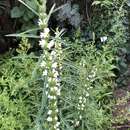Description
provided by eFloras
Herbs annual or biennial. Taproots with dense, fibrous rootlets. Stems erect, 30-120 cm, retrorse strigose, nodes and angles densely strigose. Petiole of stem leaves 0.5-3 cm, narrowly winged at apex; lower stem leaf blades ovate, base broadly cuneate, 3-palmatipartite; lobes oblong-rhombic to ovate, 2.5-6 × 1.5-4 cm, pinnately divided, adaxially strigose, abaxially pilose, glandular; mid stem leaf blade rhombic, palmatipartite, lobes oblong-linear, base narrow cuneate. Verticillasters 8-15-flowered, 2-2.5 cm in diam.; floral leaves subsessile, linear to linear-lanceolate, 3-12 × 2-8 mm, entire or dentate; bracteoles spiny, shorter than calyx, ca. 5 mm, appressed puberulent. Flowers sessile. Calyx tubular-campanulate, 6-8 mm, appressed puberulent; teeth broadly triangular, 2-3 mm, apex spinescent. Corolla white or reddish to purplish red, 1-1.2 cm, villous; tube ca. 6 mm, inconspicuously scaly annulate inside; upper lip straight, concave, oblong, ca. 7 × 4 mm, margin entire, ciliate; lower lip slightly shorter, base sparsely scaly; middle lobe obcordate, base constricted, margin membranous, apex emarginate; lateral lobes ovate. Filaments sparsely scaly. Nutlets brownish, oblong, triquetrous, ca. 2.5 mm, base cuneate, apex truncate, smooth. Fl. Jun-Sep, fr. Sep-Oct.
- license
- cc-by-nc-sa-3.0
- copyright
- Missouri Botanical Garden, 4344 Shaw Boulevard, St. Louis, MO, 63110 USA
Distribution
provided by eFloras
Himalaya (Kashmir to Nepal), Tibet, India east to China, Amur, Japan, Malaysia.
- license
- cc-by-nc-sa-3.0
- copyright
- Missouri Botanical Garden, 4344 Shaw Boulevard, St. Louis, MO, 63110 USA
Distribution
provided by eFloras
Anhui, Fujian, Gansu, Guangdong, Guangxi, Guizhou, Hainan, Hebei, Heilongjiang, Henan, Hubei, Hunan, Jiangsu, Jiangxi, Jilin, Liaoning, Nei Mongol, Ningxia, Qinghai, Shaanxi, Shandong, Shanxi, Sichuan, Taiwan, Xinjiang, Xizang, Yunnan, Zhejiang [Cambodia, Japan, Korea, Laos, Malaysia, Myanmar, Thailand, Vietnam; Africa, North America, South America]
- license
- cc-by-nc-sa-3.0
- copyright
- Missouri Botanical Garden, 4344 Shaw Boulevard, St. Louis, MO, 63110 USA
Synonym
provided by eFloras
Leonurus artemisia (Loureiro) S. Y. Hu; L. heterophyllus Sweet; Stachys artemisia Loureiro.
- license
- cc-by-nc-sa-3.0
- copyright
- Missouri Botanical Garden, 4344 Shaw Boulevard, St. Louis, MO, 63110 USA
Leonurus japonicus: Brief Summary
provided by wikipedia EN
Leonurus japonicus, commonly called oriental motherwort or Chinese motherwort, is a herbaceous flowering plant native to Asia, including Korea and Japan, and China to Cambodia.
- license
- cc-by-sa-3.0
- copyright
- Wikipedia authors and editors

